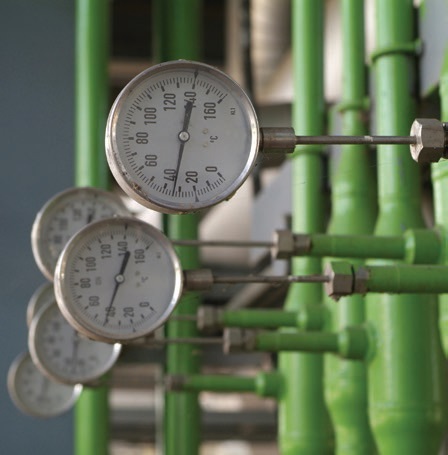Viscosity, temperature and pressure
R. David Whitby | TLT Worldwide May 2017
To devise the most efficient system, lubrication engineers should pay special attention to these factors.

An increase in temperature or a decrease in pressure weakens the intermolecular forces in a fluid.
© Can Stock Photo / epixx
IN MY LAST COLUMN I DESCRIBED DIFFERENT TYPES of fluid flow, including dynamic viscosity, kinematic viscosity, Newtonian fluids and non-Newtonian fluids. I left a discussion of the effects of temperature and pressure on viscosity to this column.
An increase in temperature or a decrease in pressure weakens the intermolecular forces in a fluid. This invariably leads to a reduction in viscosity. Hence, the viscosity of a fluid should always be quoted at a specific temperature and pressure. If the pressure is omitted, it is generally understood to be atmospheric pressure—although this can vary slightly, depending on time, location and weather.
As a result, for all fluids as the temperature increases, the viscosity decreases. Some fluids are less sensitive to changes in viscosity with temperature; for oils (whether mineral or synthetic), these fluids are said to have a high viscosity index.
Viscosity can be plotted against temperature, but there is no fundamental mathematical relationship that will completely predict the variation of viscosity with temperature for complex fluids such as mineral oils. Fortunately, by choosing suitable logarithmic axes, it is possible to arrange the viscosity/temperature measurements of the great majority of mineral oils on straight lines. This simplifies the plotting and extrapolation of the data.
Charts of viscosity versus temperature for mineral and synthetic oils are based on the Walther equation:
log
10log
10 (ν + a) = b + c log
10 T
where ν is kinematic viscosity; a, b and c are constants; and T is absolute temperature.
Consequently, for any particular oil, measurements of kinematic viscosity at two selected temperatures are all that are required to predict the viscosity at another temperature, provided the extrapolation is not carried into the region of the oil’s pour point. Most usually, the two temperatures selected for measuring kinematic viscosity are 40 C and 100 C.
In 1929 Dean and Davis devised a system to express the viscosity/temperature relationship of an oil. The system, viscosity index (VI), was based on the viscosities of base oils obtained from a paraffinic Pennsylvanian crude oil, which was arbitrarily assigned a VI of 100, and base oils obtained from a naphthenic Gulf Coast crude oil, which was assigned a VI of 0. These two crude oils were chosen because, at that time, they appeared to have the maximum and minimum limits of viscosity/temperature sensitivity. They would therefore represent the end points of a 0-100 scale of VI. As I and others have written previously, VI is a purely mathematical concept intended to represent the different viscosity/temperature relationships of different oils.
Only at pressures above about 3,000 psi (206 bar, 210 kg/cm
2) does pressure begin to cause a significant increase in the viscosity of mineral oils. At 5,000 psi (345 bar, 350 kg/cm
2) the viscosity of a typical Group I base oil is approximately double its viscosity at atmospheric pressure. At higher pressures, the rate of viscosity increase accelerates. At very high pressures mineral oils cease to behave like liquids and tend to become waxy solids.
For mineral oils, the most convenient mathematical relationship between absolute viscosity and pressure, at any specific temperature, is an exponential one of the form:
η
p = η
o exp γp
where η
p is the absolute viscosity at pressure p, η
o is the absolute viscosity at atmospheric pressure, γ is the pressure viscosity coefficient for the oil being examined and p is the applied pressure.
This relationship becomes less satisfactory at pressures above about 20,000 psi (1,380 bar), for example in point contacts. Pressure viscosity coefficients are different for different types of oils, particularly for synthetic oils. Because the pressure/viscosity relationship is in an exponential form, data are usually graphed on a logarithmic basis.
The effects of temperature and pressure on different oils is another reason why lubrication engineers need to pay special attention when designing and servicing lubrication systems.
 David Whitby is chief executive of Pathmaster Marketing Ltd. in Surrey, England. You can reach him at pathmaster.marketing@yahoo.co.uk
David Whitby is chief executive of Pathmaster Marketing Ltd. in Surrey, England. You can reach him at pathmaster.marketing@yahoo.co.uk.